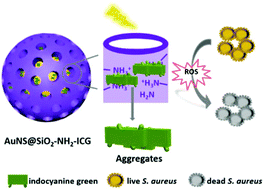Enhanced type I photoreaction of indocyanine green via electrostatic-force-driven aggregation†
Abstract
Owing to the strong NIR absorbance, indocyanine green (ICG) has attracted new attention in emerging photo-theranostics. However, ICG has a very low ROS production efficiency and mainly works through the type II photoreaction via its monomer. The aggregation tendency of ICG in aqueous milieus further worsens the scenario. Herein, ICG aggregates show an enhanced type I photoreaction pathway and have much better photooxidizing capability than its monomer, which improves the performance of ICG in the photodynamic inactivation of bacteria. This finding provides a feasible way to tackle the contradiction of ROS generation and ICG aggregation. Finally, the photodynamic effect of ICG aggregates was combined with the photothermal effect of gold nanorods to achieve an effective treatment of bacterial infection.



 Please wait while we load your content...
Please wait while we load your content...